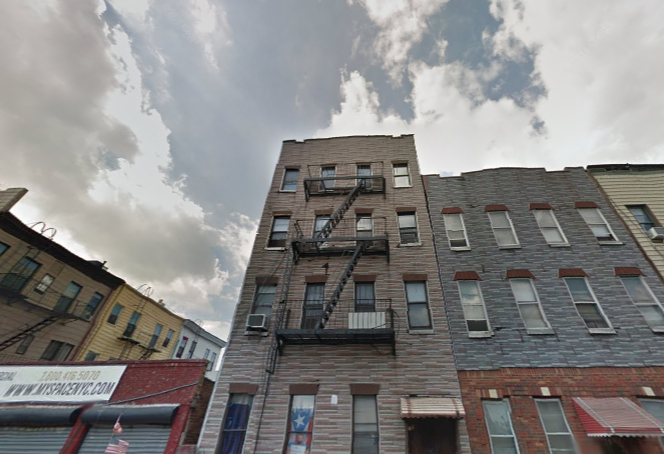
There are more than 20 housing-code violations per apartment in this Bushwick building.
There are two things you can say about the building at 159 Suydam Street in Bushwick. One is that it is improving. The other is that it is still a disaster.
The four-story building currently has 166 open housing-code violations, according to a database maintained by the city’s Department of Housing Preservation and Development (HPD). That’s an improvement over the 207 violations the property sported in August, when five tenants went to state court asking that an administrator be appointed to operate the building.
The situation, however, remains grim. “Our clients still have no cooking gas,” says attorney Ariana Marmora of MFY Legal Services. At least the lights are on now; Con Ed moved to shut them down during the fall. The seven-unit building’s current roster of code violations—which besides the gas issues include broken plaster, blocked exits, plywood in place of doors and multiple leaks—work out to an extraordinary 24 per apartment.
At least since the 1970s fiscal crisis saw landlord abandonment and neglect on a cataclysmic scale, New York City lawmakers, policymakers and advocates have employed a range of tactics to ensure that property owners provide decent places for renters to live. Some of these tools have proven very effective.
But the building at 159 Suydam Street illustrates the difficulties involved in applying those rules to certain kinds of buildings with a certain sort of landlord. It’s a building that might be too small for the most aggressive enforcement tools, with a landlord who appears to rarely if ever seek building permits or other regulatory approvals that city agencies might use as leverage. And it’s taken a court six months to take action on tenants’ complaints of rats, roaches, mice, bedbugs, an accumulation of trash and more.
Back taxes, building-code blotches and a bribe
The housing code violations are hardly the only problem facing the building and its owner, Damian Campasano. According to a February tax bill, he owes $44,000 in past-due property taxes on the parcel. In the past year, the Department of Buildings has levied three fines against the property for violating the building code, and the structure was ordered partially vacated last year—the third such order since 2007.
Bushwick is widely considered the leading edge of the wave of gentrification and displacement that has remade large parts of Brooklyn. Large segments of the neighborhood are still home to working-class Latinos but there is fear that landlords will try to clear out current renters to make space for newcomers with fatter wallets. Some believe that is what is happening at 159 Suydam.
“This is just the start of what’s happening in Bushwick,” Assemblywoman Maritza Davila said at a press conference inside a poorly plastered living room at the building last Thursday. “This will trickle down to other communities.”
The tenants and landlord were back in court last week to see Housing Court Eleanora Ofshtein rebuff a bid by Campasano to dismiss the case. There was progress at the same hearing toward a settlement, Marmora says, but a trial is still possible on April 4 to hear tenants’ case for a designation under the 7A program.
“The landlord has two options,” the attorney said at last week’s press conference. “He can do what’s right by the tenants or we will demonstrate out case in court.”
The previous owner, Frank Campasano, held the building from 1979 until September 2014, when he transferred it to his son. The elder Campasano was arrested the following February and accused of bribing two city inspectors, who were also busted, to enter the building and try to convince tenants that it had been ordered fully vacated. According to public records, Campasano pleaded guilty last August to a misdemeanor and was sentenced to 100 hours of community service. One of the inspectors, Luis Soto, who was accused of a raft of misconduct, is currently serving a 30- to 90-month sentence at Franklin Correctional Facility.
The Campasanos are linked to other buildings in the area. An attorney representing Damian Campasano did not return a call and email requesting comment.
Which program fits?
The 7A program appoints administrators to run troubled buildings, collect rent and oversee repairs. City Limits reported in 2013 that the city had moved away from using the 7A program. According to annual reports the city sends the federal government, 54 apartments exited the 7A program in 2014, up from six the year before but down from 93 units in 2012.
HPD has rolled out other ways of cracking down on bad buildings, such as the Alternative Enforcement Program, which as of the end of fiscal 2015 last July included 581 buildings and had discharged more than 1,000 since it began in 2007. The Suydam Street building is in that program.
Some AEP buildings end up in 7A administration. But a 2014 HPD report said, “Not all AEP properties are good candidates for 7A. The small size of many buildings make them poor candidates for 7A as one of the main criteria for 7A is that the building can sustain itself (cover at least maintenance costs) based on the rental income. Many of the small buildings, in several cases not even fully occupied, cannot sustain themselves financially.”
Under the Emergency Repair Program, the city did more than $11.2 million in work in fiscal 2015. HPD reports that it has done nearly $28,000 of emergency repair work on 159 Suydam, including testing for lead, repairing leaks and installing window guards.
One tool that some have suggested the city use to discipline exploitative landlords—making access to building permits contingent on steering clear of tenant harassment—apparently wouldn’t have much effect at 159 Suydam. According to the Department of Buildings, not a single permit has been granted on the site, which tracks documents going back decades.








